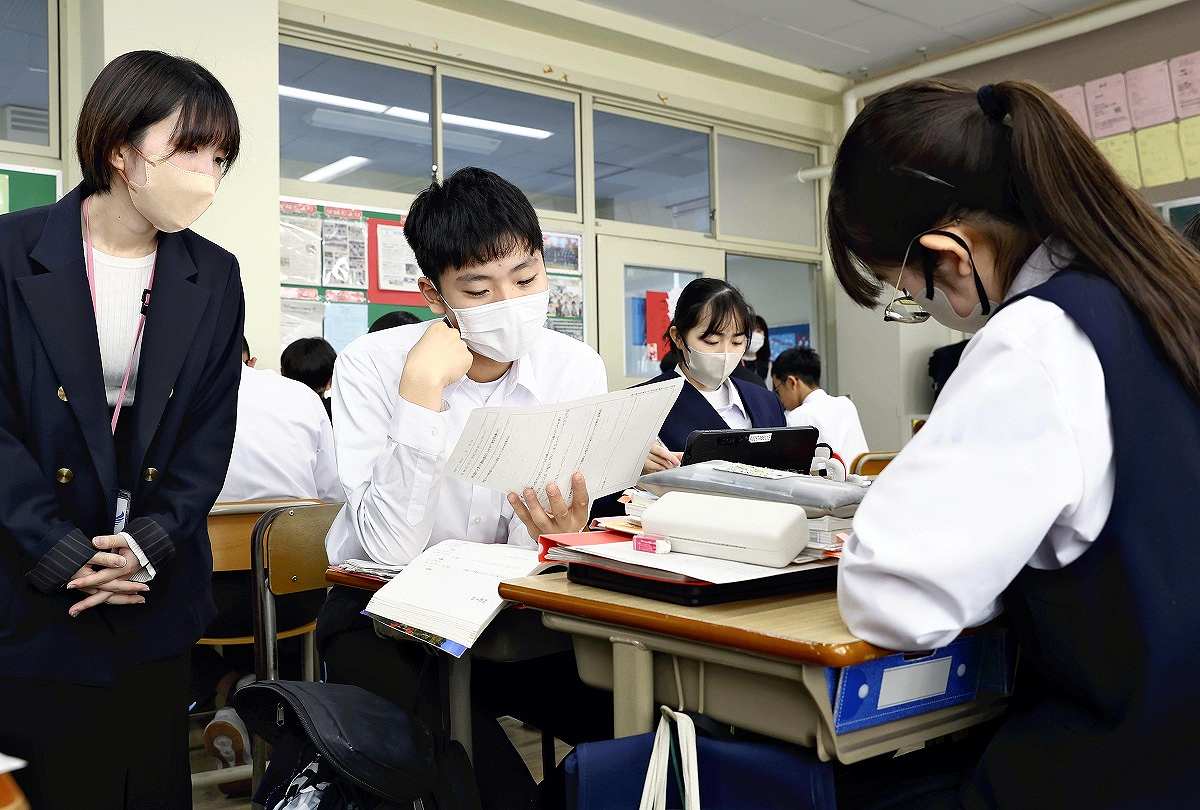Japan’s Strategy Bears Fruit in 2022 PISA Results, But Challenges Still Remain in Students’ Reading Skills

Students read texts before giving a presentation on Nov. 27 at Sashiogi Junior High School in Saitama.
21:00 JST, December 6, 2023
Japanese high school students’ reading scores significantly improved in a recent global academic achievement survey, advancing from the previous rank of 15th place among 81 countries and regions to third. But students still seem to struggle with the same questions, a sign that they have not fully overcome their weaknesses yet.
The Organization for Economic Cooperation and Development (OECD) announced Tuesday the results of its Program for International Student Assessment (PISA) survey for 2022. It gauged the reading, mathematics and science literacy of about 690,000 15-year-old students worldwide.
PISA-specific education
On Nov. 27 at a Japanese class in Saitama City’s Sashiogi Junior High School, second-year students chose their favorite tanka poems from textbooks and read several explanatory articles about the poems online before presenting their thoughts about the articles’ references that caught their attention, along with their reasons for citing the references.
“This curriculum gives our students more opportunities to deepen their thoughts before making presentations,” a 29-year-old teacher said. “They have begun building an ability to find the information they need.”
The Education, Culture, Sports, Science and Technology Ministry cited a curriculum that focuses on developing students’ thinking power as one reason for the improvement in reading skill in the PISA scores.
PISA’s reading section assesses students’ ability to find key information in a text and explain their thoughts while providing evidence. Japanese students seem to struggle with this type of question. So, starting from the 2020 academic year, the ministry’s guidelines for elementary, junior high and high schools have promoted enhancing students’ ability to think and express ideas, spurring schools to teach so-called PISA-specific reading skills.
However, the OECD cites the short period of school closures amid the coronavirus pandemic as one of the reasons for Japan’s high ranking. The percentage of students in Japan who said their school was closed for more than three months was 15.5%, far below the OECD average of 50.3%.
In Japan, even amid the pandemic, schools provided face-to-face classes by means of staggered attendance and small groups, while taking COVID-19 prevention measures.
Verification needed
Despite Japan’s significant improvement in the PISA rankings for reading, it remains questionable whether students really have acquired skills that have been lacking.
One question on which Japan had a lower performance than the OECD average in the previous PISA asked students to compare a corporate website that advertises microwaves with online magazine articles and then find information necessary to confirm the safety of the products. The same question was asked this time, but the percentage of acceptable answers was 56.8%, almost unchanged from the previous survey.
Related to this question, a question to evaluate the credibility of information and explain one’s opinion while providing evidence also had a low percentage of acceptable answers at 14.3%.
This year’s average reading score of 516 points fell short of the 538 that was scored in 2012. “We can’t really say that Japanese students have overcome their weakness,” a ministry official said.
Shumpei Komura of Benesse Education Research and Development Institute said, “The ministry needs to properly verify whether Japan’s improved ranking is due to external factors such as the pandemic or the result of improved teaching.”
What’s PISA?
Since 2000, PISA has been conducted once every three years to assess the ability of 15-year-olds to use the knowledge and skills they have acquired during their compulsory education. Due to the coronavirus pandemic, the survey scheduled for 2021 was postponed to 2022.
Questions are asked in three fields: reading, mathematics and science literacy, with one of them being set as the main subject of the survey for the year. The standard score on each field is statistically adjusted to 500 points, allowing for comparisons by country or region and over time.
The 2022 survey was conducted from June to August last year in Japan, with about 6,000 first-year high school students from 183 randomly selected schools nationwide participating in the survey.
Japan’s 2022 average reading score of 516 was up by 12 points from the previous survey and was 40 points above the OECD average. Japan ranked fifth in mathematics, compared to sixth last time, and second in science, compared to fifth.
Elsewhere, China — limited to students from Beijing, Shanghai, Jiangsu and Zhejiang — which ranked first in all three areas in the previous survey, did not participate in the 2022 survey due to the pandemic, while Russia and Belarus were not given the right to take part in the survey. This time, Singapore dominated first place in all three areas.
"Society" POPULAR ARTICLE
-

M4.9 Earthquake Hits Tokyo, Neighboring Prefectures
-

M7.5 Earthquake Hits Northern Japan; Tsunami Waves Observed in Hokkaido, Aomori and Iwate Prefectures
-

Tsukiji Market Urges Tourists to Avoid Visiting in Year-End
-

Israeli Tourists Refused Accommodation at Hotel in Japan’s Nagano Pref., Prompting Protest by Israeli Embassy and Probe by Prefecture
-

M5.7 Earthquake Hits Japan’s Kumamoto Pref., Measuring Upper 5 Intensity, No Tsunami Expected
JN ACCESS RANKING
-

Keidanren Chairman Yoshinobu Tsutsui Visits Kashiwazaki-Kariwa Nuclear Power Plant; Inspects New Emergency Safety System
-

Imports of Rare Earths from China Facing Delays, May Be Caused by Deterioration of Japan-China Relations
-

University of Tokyo Professor Discusses Japanese Economic Security in Interview Ahead of Forum
-

Japan Pulls out of Vietnam Nuclear Project, Complicating Hanoi’s Power Plans
-

Govt Aims to Expand NISA Program Lineup, Abolish Age Restriction























